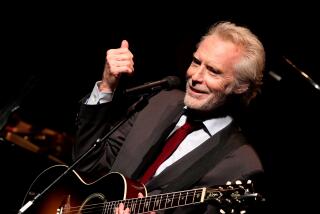Gene Lees dies at 82; jazz historian and critic
Gene Lees, a jazz historian and critic known for his pugnacious, highly personal essays and biographies of such jazz greats as Oscar Peterson, Woody Herman and Johnny Mercer, died Thursday at his home in Ojai. He was 82.
Lees had struggled for many years with heart disease, said family friend Leslie A. Westbrook.
FOR THE RECORD:
Gene Lees obituary: The obituary of jazz historian and critic Gene Lees in Saturday’s LATExtra section misspelled the first name of his son, Philip, as Phillippe. —
A Canadian by birth who moved to Ojai more than 30 years ago, Lees was also a lyricist and composer who wrote the words for a number of classics, including the English lyrics for Brazilian composer Antonio Carlos Jobim’s “Quiet Nights of Quiet Stars.” As a collaborator, Lees also wrote “Waltz for Debby” with pianist Bill Evans and “The Right to Love” with composer Lalo Schifrin.
Lees also had the distinction of collaborating with a pope: He translated poems written by Pope John Paul II when the latter was a Polish priest named Karol Wojtyla. The result was a cycle of songs recorded in 1985 called “One World, One Peace.” Sarah Vaughan was the vocalist.
A former editor of Downbeat, the influential jazz magazine, Lees was most prolific as a critic and historian, writing essays on jazz and other topics for the Gene Lees Jazzletter, a private monthly newsletter he founded in 1981 that had more than 1,000 subscribers, including many musicians.
Former New Yorker editor Robert Gottlieb, who excerpted two Lees pieces in his 1996 anthology “Reading Jazz,” described Lees as “a strong presence in jazz” who was “equally fierce as advocate and enemy —outspoken, passionate, even polemical.”
Gottlieb said Lees was “at his formidable best” in the appreciations he wrote on musicians he knew intimately, such as Evans, the influential pianist whose heroin habit contributed to an early death in 1980 at 51. Lees, as critic Nat Hentoff once wrote, was “one of the relatively few chroniclers left who has known the musicians he writes about long and well.”
Among Lees’ 18 books are “The Modern Rhyming Dictionary: How to Write Lyrics” (1981), “Oscar Peterson: The Will to Swing” ( 1988), “Waiting for Dizzy” (1991), “Cats of Any Color: Jazz Black and White” (1994), “Leader of the Band: The Life of Woody Herman” (1995) and “You Can’t Steal a Gift: Dizzy, Clark, Milt and Nat” (2001). He recently completed a biography of band leader Artie Shaw.
Eugene Frederick John “Gene” Lees was born Feb. 8, 1928, in Hamilton, Canada. He attended Ontario College of Art in Toronto and from 1948 to 1955 worked as a journalist at several Canadian newspapers.
In 1955 he moved to Kentucky, and for the next three years he was a critic and editor for the Louisville Times.
In 1959 he became editor of Downbeat but stayed for less than two years. He gave a number of explanations for leaving in 1961, including his refusal to stop putting black musicians on the cover.
After leaving Downbeat he joined a State Department tour of South America with the Paul Winter Sextet. In Brazil he met Jobim. “I told Jobim that his songs could be done in English and I showed him what could be done. . . . I wrote ‘Quiet Nights of Quiet Stars’ on a bus going to Belo Horizonte and mailed it back to him in Rio. It was my first professional lyric,” he told Harrigan Logan for an article published in 2006 on the website of the Robert Farnon Society.
After “Quiet Nights” became a hit in the United States, Lees had more collaborations with Jobim and other bossa nova artists. Lees “helped take bossa nova into a broader American market by writing English lyrics,” said jazz critic Don Heckman.
Lees’ love of jazz began when he was 12. While riding his bike near Niagara Falls, he noticed a crowd of people outside a ballroom and sneaked through a side door, where he glimpsed “this amazing scene of these gleaming instruments and these dapper, self-contained men.” Those men were members of the Duke Ellington band. “They started out with ‘Take the A Train’ and wham! It took my breath away,” he recalled in a 1993 Newsday interview. “I got hopelessly strung out on that music from then on.”
A couple of decades later, as Downbeat editor, he began to meet the jazz greats whose music he loved and eventually shared a stage with some of them, including Dizzy Gillespie. In his piece “Waiting for Dizzy,” he wrote: “There is a gesture he has, a motion, that always reminds me of a great batter leaning into a hit. He has a way of throwing one foot forward, putting his head down a bit as he silently runs the valves, and then the cheeks bloom out in the way that has mystified his dentist for years, and he hits into the solo. When that foot goes forward like that, you know that John Birks Gillespie is no longer clowning. Stand back.”
Lee’s wife of 39 years, Janet Suttle Lees, plans to continue publishing the Jazzletter. He is also survived by a son from a previous marriage, Phillippe; a sister, Victoria Lees; and a brother, David. Services will be private.
More to Read
Start your day right
Sign up for Essential California for the L.A. Times biggest news, features and recommendations in your inbox six days a week.
You may occasionally receive promotional content from the Los Angeles Times.







